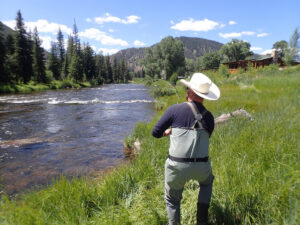What bugs should you use for the best chance to catch a monster trout? Master Fly Fishing Guide, Ben Riedel provides the answer in his July Taylor River Fishing Report.
Current Taylor River flows at Wilder are hovering around 380cfs. Outflow at Taylor Park Reservoir is at 305cfs and it won’t be reduced until the end of July. Water temps are fluctuating from 48 degrees in the morning to 58 degrees by dusk. The river looks great and is fishing really well!

Bugs are becoming more active everyday. Midges, Caddis, Yellow Sallies, Golden Stones, PMDs, BWOs, and the occasional Green Drake are all on the menu. Look for Yellow Sallies throughout the morning. They range in sizes fro
m a #12-20. A yellow stimulator in appropriate size or yellow sally dries are getting the job done. Size 16-18 PMDs have been hatching late morning into early afternoon. Dry dropper rigs with Para Adams, Para PMDs, Pheasant Tails, and Hares Ears are all reliable options for a PMD hatch. BWOs have been coming off early in the afternoon. Para BWOs and Micro Mayflies in the #16-20 variety should produce fish. If fish are suspended higher in the water column “rolling” on the surface, don’t be afraid to drop an emerger pattern off the back of a bigger dry fly you CAN see.
Keep an eye out for big bugs! Golden Stones and Green Drakes are starting to show up. Golden Stones hatch at night but adults fly around during the heat of the day. A large Golden Stone dry fly or Chubby Chernobyl in golden color will move some fish (and make a great indicator). I have only seen a handful of Green Drakes so far but I expect them to show up in earnest within days. Even though the primary hatch has yet to come, fish have seen them already and a big Green Drake dry fly or olive Hare’s Ear (#12-14) is a nice meal for a trout.

Caddis flies provide some good action after the mayfly hatch is over. Fish look for egg laying caddis all day but mid to late afternoon especially. Elk Hair Caddis(color and size to match), and Peacock Caddis should work for dries. If you see Caddis flies coming off the water, drop a Caddis emerger or Prince Nymph off the back of your Caddis dry fly. Fish do eat hatching Caddis adults but they know that the adult Caddisflies are agile and hard to catch, so they tend to focus on the vulnerable emerging stage.
The Dream Stream is fishing really well. Mayflies and Caddisflies make up the majority of active bugs right now. Expect Midges all day with Mayflies and Caddis making their emergence between mid morning and mid afternoon. Dry fly only and dry dropper rigs are the best method for presenting to these spooky fish. We’ve had success with flies like Para Adams #14-22, Elk Hair Caddis #14-18, Para Madam X #12-16, Pheasant Tails #16-20, Hare’s Ears #16-20, Zebra Midges #16-20, BWO emergers, and Caddis pupae. As always, approaching with stealth, and making the first cast count, will be the key to success on the stream.

The Ponds are experiencing Damselfly, Midge, and Mayfly hatches. Look for most of the bug activity to happen from 10-2ish. Damselflies have been hatching late morning into early afternoon depending on the weather. Sight fishing during a Damselfly hatch can seem easy after a few fish explode on your dry, but to catch the big fish, accurate casts with soft landings(fly first) are paramount. Lead the fish by a few feet, if they don’t immediately eat give the fly a small twitch. Showing the fish it is alive can trigger aggressive reactionary strikes. If there aren’t any Damsels present, a size 16 Para Adams or a Griffiths Gnat are good prospecting flies to cruising fish.
As always, if you have any questions, comments or concerns, please don’t hesitate to contact me. I am happy to explain hatches in more detail, get nerdy on casting with you, or just share fish stories.
Take care,
Ben Riedel- Master Fly Fishing Guide
Wilder on the Taylor
(316)208-3517 mobile
rodandriedel@gmail.com









